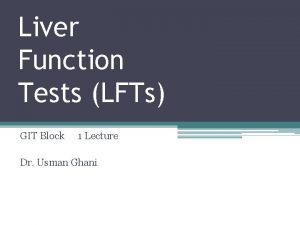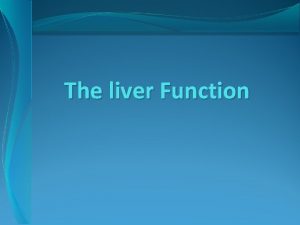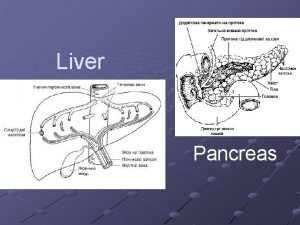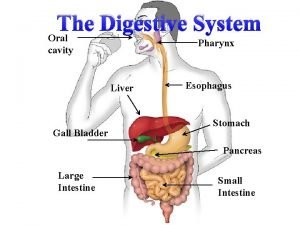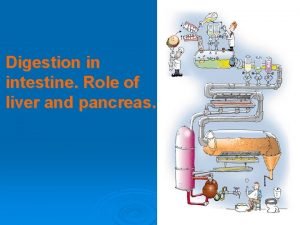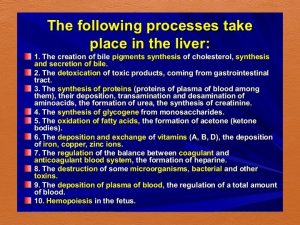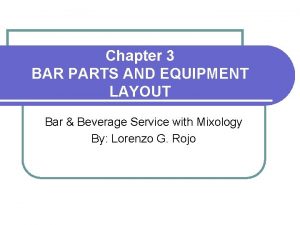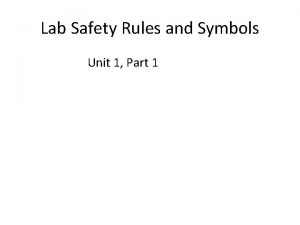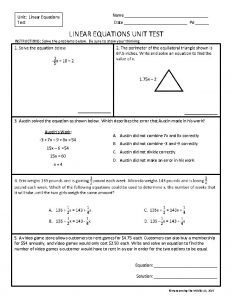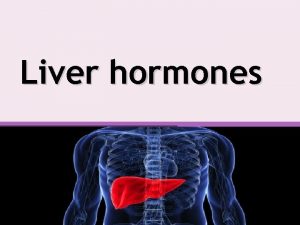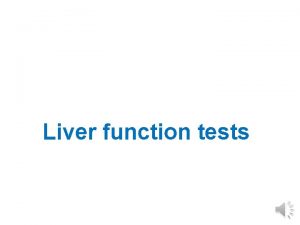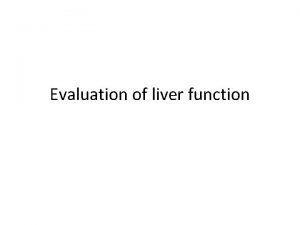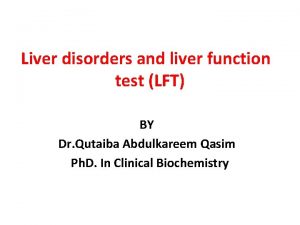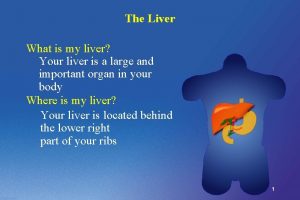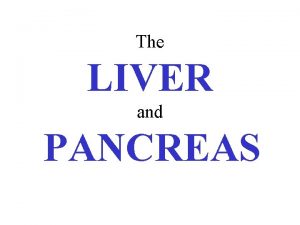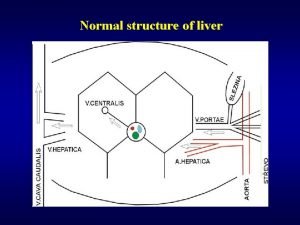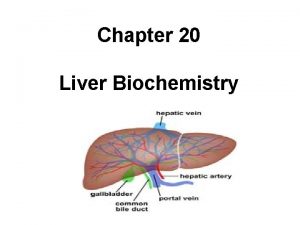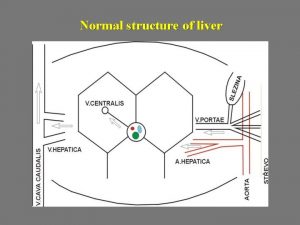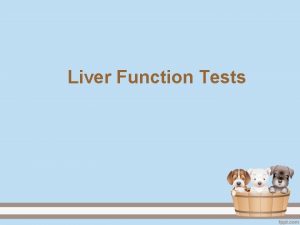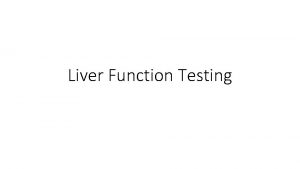Liver function test Part 1 Liver enzymeALTASTALPGGT Liver































- Slides: 31

Liver function test Part 1 Liver enzyme(ALT-AST-ALP-GGT)


• Liver is the largest Organ of the body weighing about 1. 5 Kg. • Liver is called kitchen of our body.

Major Metabolic Functions of the Liver • Synthetic Function o Plasma proteins (albumin, globulins), cholesterol, triglycerides and lipoproteins • Detoxification and excretion o Ammonia to urea (urea cycle), bilirubin, cholesterol, drug metabolites • Storage Function o Vitamins A, D, E, K and B 12 • Production of bile salts o Helps in digestion

Liver Function Tests (LFTs) • Noninvasive methods for screening of liver dysfunction • Help in identifying general types of disorder • Assess severity and allow prediction of outcome • Disease and treatment follow up

Liver Function Tests (LFTs) Broadly classified as: 1. Tests to detect hepatic injury: • • Mild or severe; acute or chronic Nature of liver injury (hepatocellular or cholestasis) 2. Tests to assess hepatic function

Classification of LFTs Group I: Markers of liver dysfunction ▫ ▫ Serum bilirubin: total and conjugated Urine: bile salts and urobilinogen Total protein, serum albumin and albumin/globulin ratio Prothrombin Time

Classification of LFTs Group II: Markers of hepatocellular injury ▫ ▫ Alanine aminotransferase (ALT) Aspartate aminotransferase (AST)

Classification of LFTs Group III: Markers of cholestasis ▫ ▫ Alkaline phosphatase (ALP) g-glutamyltransferase (GGT)


Aminotranferases • Aminotransferases or transaminases are a group of enzymes that catalyze the interconversion of amino acids and ketoacids (oxoacids) by transfer of amino group • The two aminotransferases of greatest clinical significance are: o Aspartate aminotransferase (AST), formerly termed glutamate oxaloacetate transaminase (GOT). o Alanine aminotransferase (ALT), formerly termed glutamate pyruvate transaminase (GPT). • Pyridoxal phosphate (P-5 -P) is coenzyme

Aspartate aminotransferase (AST) • AST involved in the transfer of an amino group between aspartate and -ketoacids. Mohammed Laqqan

Clinical Significance • Aspartate aminotransferase (AST) is an enzyme found primarily in the heart, liver, and muscle. • Additional AST is released into the circulation after injury or death of cells. • This test is one of several that are performed when there has been damage to the heart muscle, as in myocardial infarction, and in assessing liver damage. • Infants levels approximately twice the adult level, these decline to adult levels by approximately 6 months of age. Mohammed Laqqan

Specimen Collection • Specimen: o Serum, heparin plasma or EDTA plasma o Hemolysis should be avoided because it can dramatically increase serum AST concentrations o (RBCs contain 15 X the AST activity in serum) Mohammed Laqqan

Assay for Enzyme activity • Measurement by Karmen method • A coupled reaction involving: o pyridoxal-5 -phosphate (P-5 -P) o and malate dehydrogenase (MDH) o at 37 o. C: • Decrease in absorbance at 340 nm is determined by continuous monitoring. Aspartate + -Ketoglutarate Oxaloacetate + NADH + H AST MD Oxaloacetate + Glutamate Malate + NAD Mohammed Laqqan

• Normal range: 8 – 20 U/L • Post AMI o Rises 6 – 8 hours o Peaks at 24 hours o Returns to normal by day 5 • AST levels are highest in acute hepatocellular disorders "viral hepatitis, cirrhosis.

Alanine Aminotransferase (ALT) • A transferase with enzymatic activity similar to AST • Converts alanine + α-ketoglutarate to pyruvate and glutamate Mohammed Laqqan

Clinical Significance • It is found in the kidneys, heart, and skeletal muscle tissue but primarily in liver tissue. • The test is used mainly in the diagnosis of liver disease and to monitor the effects of hepatotoxic drugs. • Often higher than AST with liver damage and tend to remain elevated longer(More liver-specific than AST) • Remains normal in AMI Mohammed Laqqan

Specimen Collection • Specimen: o Serum, heparin plasma or EDTA plasma o Hemolysis should be avoided because it can increase serum ALT concentrations o (ALT in RBCs is roughly 5 X that of serum) Mohammed Laqqan

Assay for enzyme activity • The most common method in use today for measurement of ALT activity utilizes a coupled enzymatic procedure for monitoring disappearance of NADH. • In this approach lactate dehydrogenase (LDH) and its required cofactors are added and catalyze the conversion of pyruvate to lactate • This causes simultaneous oxidation of reduced nicotinamide adenine dinucleotide (NADH). • The disappearance of NADH is followed spectrophotometrically (at 340 nm). Alanine + -Ketoglutarate Pyruvate + NADH + H ALT LD Pyruvate + Glutamate Lactate + NAD

• Normal range (U/L): ▫ Male: 13 -35 ▫ Female: 10 -30 • High serum levels in acute hepatitis (300 -1000 U/L) • Moderate elevation in alcoholic hepatitis (100 -300 U/L) • Minor elevation in cirrhosis, hepatitis C and non-alcoholic steatohepatitis (NASH) (50 -100 U/L)

Levels of AST & ALT • AST is assessed along ALT in monitoring liver damage. • These two values normally exist in an approximately 1: 1 ratio. • As a rough guide: o AST>ALT in: • alcoholic hepatitis and cirrhosis, • metastatic cancer of the liver • non-biliary cirrhosis, o while ALT>AST in: • viral and drug hepatitis, • chronic hepatitis C • and hepatic obstruction. Mohammed Laqqan

Alkaline Phosphatase (ALP) • Phosphatases transfer a phosphate moiety from one group to a second, forming an alcohol and a second phosphate compound. • The optimal reaction p. H for ALP is between 9 and 10 and varies with the buffer and substrate. • ALP requires Mg 2+ as an activator Mohammed Laqqan

Isoenzymes • • • ALP exists as a number of isoenzymes Major are those found in Liver, bone, placenta, and then intestinal fraction Electrophoresis for isoenzyme analysis • • • Liver isoenzyme (fastest) Bone isoenzyme Placental isoenzyme Intestinal isoenzyme (slowest) Immunochemical methods now available Mohammed Laqqan

Clinical Significance • Alkaline phosphatase (ALP) is an enzyme found in the liver, bone, placenta, intestine, and kidneys • Primarily in the cells lining the biliary tract and in the osteoblasts involved in the formation of new bone. • ALP is normally excreted from the liver in the bile. • Increased ALP levels are found most commonly during: • periods of bone growth (as in children), • in various types of liver disease, • and in biliary obstruction. • Serum ALP activity primarily reflects changes in bone and liver function, even though higher ALP activities can be found in other organs. Mohammed Laqqan

Specimen Collection • Blood should be drawn after a fast of at least 8 hours. • Serum or heparinized plasma. • Slight hemolysis is tolerable, but gross hemolysis should be avoided. • These increases may be caused by: o the release of ALP from complexes with lipoproteins, • It is best to analyze ALP specimens the same day they are drawn. • ALP is inhibited by metal-complexing anticoagulants; EDTA, oxalate, and citrate inhibit the enzyme by complexing Mg 2+ and should not be used. Mohammed Laqqan

Assay for Enzyme activity • almost all assays for ALP employ p-nitrophenyl phosphate as the substrate. • Bowers and Combs method based on absorption of pnitrophenol at 405 nm • At an alkaline p. H, o p-nitrophenyl phosphate is colorless; o the product p-nitrophenol is intensely yellow

• Normal range: 40 – 125 U/L

γ-Glutamyltransferase (GGT) • Transfers γ-glutamyl residue from γ-glutamyl peptides (usually glutathione) to amino acids, H 2 O and other small peptides o glutathione serves as the γ-glutamyl donor GGT Glutathione + Amino Acid glutamyl-peptide + L-cysteinylglycine • High concentrations in liver tissue • Also in pancreas and kidney

Diagnostic Significance • Increased plasma GGT is associated with o Hepatobiliary disease • Highest seen in biliary obstruction o Alcoholic cirrhosis • Used with ALP to differentiate between liver and bone diseases

Assay for enzyme activity • γ- glutamyl residue of γ glutamyl-p-nitroanilide is transferred to glycylglycine, releasing p-nitroaniline L-γ-glutamyl-p-nitroanilide + glycylglycine p-nitroaniline + y-glutamyl glycylglycine GGT • The rate of liberation of p-nitroaniline is directly related to the GGT activity in the sample and is quantitated by measuring the increase in absorbance at 405 nm. Reference Range: male, 6 -45 U/L (37°C); female, 5 -30 U/L (37°C)
 Liver function tests normal values
Liver function tests normal values Functions of kidney
Functions of kidney Unit test review algebra 2
Unit test review algebra 2 5 functions of the liver
5 functions of the liver Liver and pancreas function
Liver and pancreas function Duodenum function
Duodenum function Synthetic function of liver
Synthetic function of liver Role of liver in digestion
Role of liver in digestion Function of liver physiology
Function of liver physiology What is the primary function of the liver
What is the primary function of the liver Lft profile
Lft profile Part whole model subtraction
Part whole model subtraction Part to part ratio definition
Part to part ratio definition Brainpop ratios
Brainpop ratios Part by part technical description example
Part by part technical description example Layout dispense bar diagram
Layout dispense bar diagram The phase of the moon you see depends on ______.
The phase of the moon you see depends on ______. Part to part variation
Part to part variation Diagram of bean seed with labels
Diagram of bean seed with labels What is the sepal function in a flower
What is the sepal function in a flower The male part of a flower is
The male part of a flower is Chip extractor function
Chip extractor function Function of microscope
Function of microscope Objectives of plant format
Objectives of plant format Functions of parts of a plant
Functions of parts of a plant Fce test
Fce test Fahrenheit 451 part 3 test
Fahrenheit 451 part 3 test 2. part two—preparing a chart of accounts
2. part two—preparing a chart of accounts Test the hypothesis part 3 lab safety answer key
Test the hypothesis part 3 lab safety answer key Equations and inequalities unit test part 1
Equations and inequalities unit test part 1 Expressions equations and inequalities unit test
Expressions equations and inequalities unit test Linear systems unit test
Linear systems unit test
